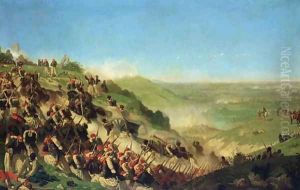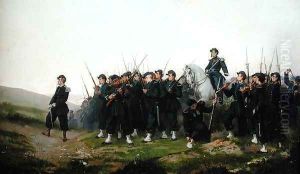Paul Alexandre Protais Paintings
Paul Alexandre Protais was a French painter born in 1826. He was known for his detailed military scenes and his ability to capture the nuances of military life and uniforms with historical accuracy. Protais’ work falls into the broader context of 19th-century French art, a period marked by a fascination with history, particularly the Napoleonic era, and a growing interest in realism.
Protais trained under influential artists of his time, which helped him develop a keen eye for detail and a robust painting technique. His paintings often featured scenes from the Napoleonic Wars and the French military campaigns, capturing the valor and the drama of the battlefield, as well as the quieter moments of soldierly life. His work was characterized by its fine detail, vibrant color palette, and the dynamic portrayal of his subjects, which brought historical events to life with a vividness that appealed to his contemporaries.
Throughout his career, Protais exhibited his work at the Paris Salon, the official art exhibition of the Académie des Beaux-Arts in Paris. His paintings were well received, earning him recognition and accolades from art critics and the public alike. Beyond the battlefield scenes, Protais also explored other subjects, including genre scenes and portraits, demonstrating his versatility as an artist. However, it is his military paintings that have left a lasting mark on the history of French art, contributing to the 19th-century romanticization of military glory and the Napoleonic legend.
Paul Alexandre Protais passed away in 1890, leaving behind a legacy that would inspire future generations of military painters. His work remains significant for its contribution to the genre of military art and its role in the cultural memory of 19th-century France. Today, his paintings can be found in museums and private collections, where they continue to be studied and admired for their historical value and artistic merit.

